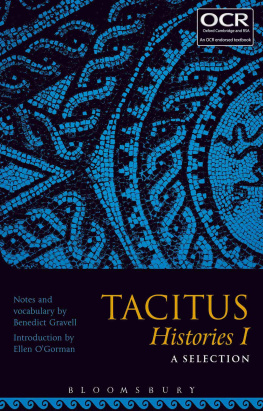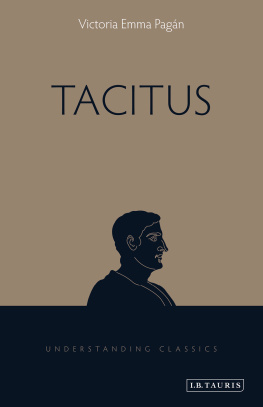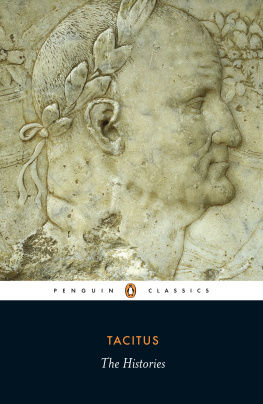Benedict Gravell - Tacitus Histories I: A Selection
Here you can read online Benedict Gravell - Tacitus Histories I: A Selection full text of the book (entire story) in english for free. Download pdf and epub, get meaning, cover and reviews about this ebook. year: 2018, publisher: Bloomsbury, genre: Detective and thriller. Description of the work, (preface) as well as reviews are available. Best literature library LitArk.com created for fans of good reading and offers a wide selection of genres:
Romance novel
Science fiction
Adventure
Detective
Science
History
Home and family
Prose
Art
Politics
Computer
Non-fiction
Religion
Business
Children
Humor
Choose a favorite category and find really read worthwhile books. Enjoy immersion in the world of imagination, feel the emotions of the characters or learn something new for yourself, make an fascinating discovery.
- Book:Tacitus Histories I: A Selection
- Author:
- Publisher:Bloomsbury
- Genre:
- Year:2018
- Rating:5 / 5
- Favourites:Add to favourites
- Your mark:
- 100
- 1
- 2
- 3
- 4
- 5
Tacitus Histories I: A Selection: summary, description and annotation
We offer to read an annotation, description, summary or preface (depends on what the author of the book "Tacitus Histories I: A Selection" wrote himself). If you haven't found the necessary information about the book — write in the comments, we will try to find it.
Tacitus Histories I: A Selection — read online for free the complete book (whole text) full work
Below is the text of the book, divided by pages. System saving the place of the last page read, allows you to conveniently read the book "Tacitus Histories I: A Selection" online for free, without having to search again every time where you left off. Put a bookmark, and you can go to the page where you finished reading at any time.
Font size:
Interval:
Bookmark:

The following titles are available from Bloomsbury for the OCR specifications in Latin and Greek for examinations from June 2019 to June 2021
Apuleius Metamorphoses V: A Selection, with introduction, commentary notes and vocabulary by Stuart R. Thomson
Cicero Philippic II: A Selection, with introduction, commentary notes and vocabulary by Christopher Tanfield
Horace Odes: A Selection, with introduction, commentary notes and vocabulary by John Godwin
Horace Satires: A Selection, with introduction, commentary notes and vocabulary by John Godwin
Ovid Amores II: A Selection, with introduction, commentary notes and vocabulary by Alfred Artley
Tacitus Histories I: A Selection, with introduction by Ellen OGorman and commentary notes and vocabulary by Benedict Gravell
Virgil Aeneid XI: A Selection, with introduction, commentary notes and vocabulary by Ashley Carter
OCR Anthology for Classical Greek AS and A Level, covering the prescribed texts by Aristophanes, Euripides, Herodotus, Homer, Plato and Xenophon, with introduction, commentary notes and vocabulary by Stephen P. Anderson, Rob Colborn, Neil Croally, Charlie Paterson, Chris Tudor and Claire Webster
Supplementary resources for these volumes can be found at www.bloomsbury.com/OCR-editions-2019-2021
Please type the URL into your web browser and follow the instructions to access the Companion Website. If you experience any problems, please contact Bloomsbury at academicwebsite@bloomsbury.com

This resource is endorsed by OCR for use with specification OCR Level 3 Advanced Subsidiary GCE in Latin (H043) and OCR Level 3 Advanced GCE in Latin (H443). In order to gain OCR endorsement, this resource has undergone an independent quality check. Any references to assessment and/or assessment preparation are the publishers interpretation of the specification requirements and are not endorsed by OCR. OCR recommends that a range of teaching and learning resources is used in preparing learners for assessment. OCR has not paid for the production of this resource, nor does OCR receive any royalties from its sale. For more information about the endorsement process, please visit the OCR website, www.ocr.org.uk.
The introduction and notes in this edition are designed to support students who are reading Tacitus Histories I in preparation for OCRs AS and A-level Latin examinations in June 2019June 2021.
The selection concerns the initial events of AD 69, the Year of the Four Emperors. The narrative is fast-paced, with rebellion and violence breaking out in the city of Rome, as the Praetorian Guard of the emperor Galba transfer their support to a controversial younger man, Otho. In his trademark prose Tacitus vividly portrays the elderly Galbas attempts to maintain order and discipline as power slips from his grasp, while Otho inspires the disorderly soldiers, keeping control only with difficulty over this volatile group of men.
The notes focus mainly on matters of language and aim to help those who have mastered the language requirements of Latin GCSE to decipher Tacitus often elusive prose. Attention is devoted primarily to issues of syntax and grammar, and the authors take the view that without a real understanding of how the Latin is working, students will not be able to engage with and comment on the text. At the end of the book is a full vocabulary list for all the words contained in the prescribed sections, with words in OCRs Defined Vocabulary List for AS Level Latin flagged by means of an asterisk.
Particular features of Tacitus style, and stylistic devices that are more difficult to spot, have also been noted in the commentary, but it has been a purposeful decision not to point out every instance of alliteration or repetition, for example, in the hope that students will make their own discoveries and develop their own ability to form views and opinions on the text. The commentary also provides help with names of people and places, specific historical events and technical terms, and this is supported by glossaries, maps and a timeline. We hope that with the help of this edition the keen student will gain an appreciation of what makes personal engagement with Tacitus and his style of historical narrative such a rewarding experience.
Ellen OGorman wrote the introduction, and Benedict Gravell the notes and vocabulary. We are particularly grateful to the very helpful comments made by Bloomsburys anonymous reviewer on the first draft, as well as OCR for their input and amendments. Thanks also go to Alice Wright and the rest of her team at Bloomsbury for all their work and professionalism.
Ellen OGorman
Benedict Gravell
May 2017
In the preface to the Histories Book I, Tacitus outlines the subject matter of his work, emphasizing the violent and revolutionary events that will occur between the years AD 69 and 96: opus aggredior opimum casibus, atrox proeliis, discors seditionibus, ipsa etiam pace saevum (Hist. I.2.1); I embark upon a history replete with disaster, ferocious with battles, torn apart by revolts, and, even in peace, savage. He goes on to list the many civil and foreign wars that occupied Rome at this time, as well as the great calamities of the period how the citizens of Rome itself set fire to and destroyed their central temple, the Capitol* (all words with asterisks are explained in the Glossary of Technical Terms), at the end of 69, and how the eruption of Vesuvius ten years later obliterated the towns of Pompeii and Herculaneum culminating with the reign of terror visited upon the senatorial class by the emperor Domitian, until his assassination in 96 (all dates in this Introduction are AD ). This dramatic series of events made up Tacitus first long historical narrative, which was probably 12 or 15 books long. Today, we have Books IIV and a small part of Book V, and most of this narrative (Books IIII) is devoted to the civil war of 69: the year of four emperors. What attracted Tacitus to this period of Roman history?
For Tacitus, the events of this year laid bare a fundamental truth about the power of emperors at Rome: that the senate may name the emperor, but it was the armies who made and sustained him as the first man in the city and the empire. Tacitus articulates this truth rather obliquely in the first chapter of our set text: evulgato imperii arcano posse principem alibi quam Romae fieri (Hist. I.4.2); When the secret of rule was made public knowledge: a princeps* (an emperor) can be made in some place other than at Rome. By alibi quam Romae Tacitus meant the legionary camps stationed around the provinces of the empire, where soldiers gathered in their own political assemblies, and acclaimed their own legionary legates, or provincial governors, with the title imperator. In this year, four successive emperors were declared in some place other than the senate of Rome: Galba, governor in Spain, was backed by the single legion* of that province and raised a second legion with the financial support of neighbouring governors; Otho was declared emperor in the Praetorian Camp stationed on the outskirts of the city, and was also backed by some troops quartered in the city;
Next pageFont size:
Interval:
Bookmark:
Similar books «Tacitus Histories I: A Selection»
Look at similar books to Tacitus Histories I: A Selection. We have selected literature similar in name and meaning in the hope of providing readers with more options to find new, interesting, not yet read works.
Discussion, reviews of the book Tacitus Histories I: A Selection and just readers' own opinions. Leave your comments, write what you think about the work, its meaning or the main characters. Specify what exactly you liked and what you didn't like, and why you think so.








